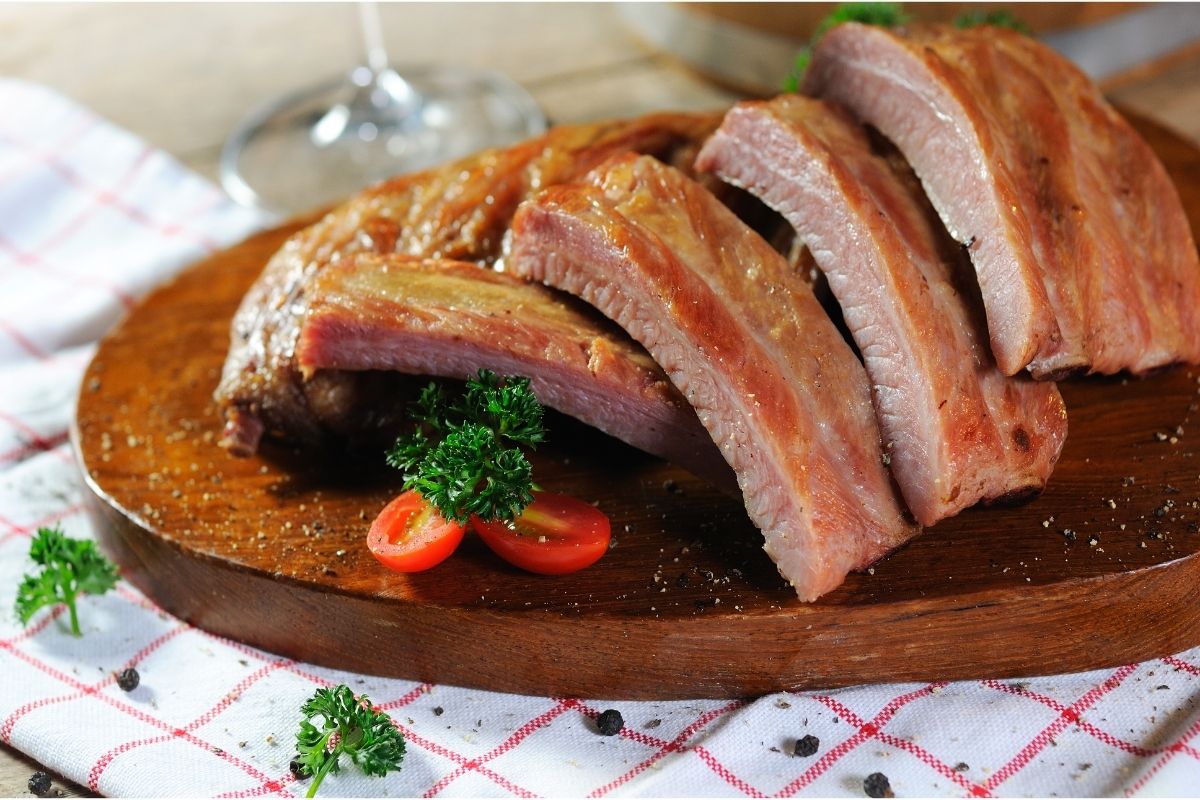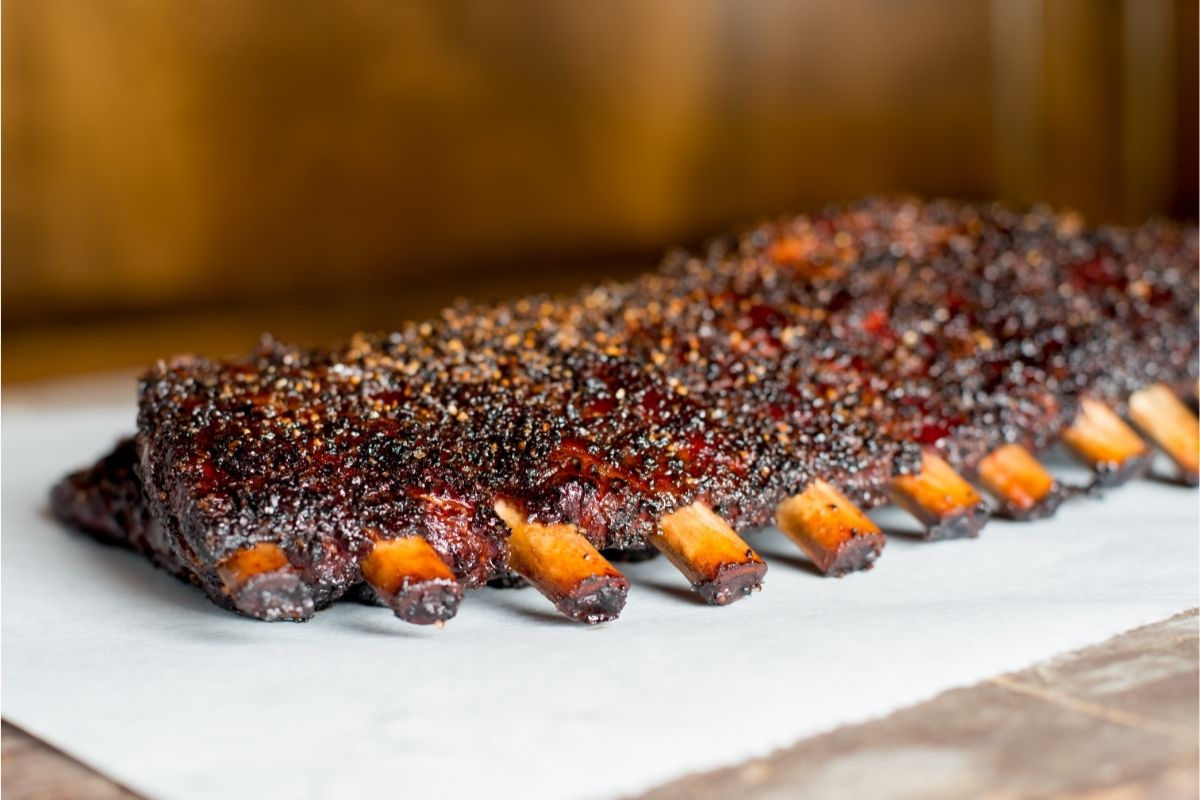If you’ve never cooked ribs before, you may run into a conundrum that still divides many barbecue lovers. Should ribs be cooked bone side up, or bone side down?
Rib novices may instinctively cook their ribs meat side down, bone side up. After all, the goal is to cook the meat, so the meat should be in contact with the heat, right? Wrong!

If you’re more experienced with cooking ribs, then you know that the best results come from cooking them bone side down.
It’s important to understand why this method works better than cooking them bone side up.
We’ll cover why ribs are better cooked bone side down, as well as why this choice even matters. You’ll also learn about different types of ribs and how they’ll look when they are grilled well.
Keep reading to find out more about why you should cook ribs bone side down, including tips on smoking ribs perfectly every time!
Should Ribs Be Smoked Bone Up Or Bone Down?
As we mentioned above, ribs will always smoke better when the bones are facing down.
The heat supply is placed just underneath the grate, but ribs will turn out better if they aren’t exposed to direct heat.
Smoking the meat side up also lets the bones absorb some of the smoke flavors, leading to a more pleasant result.
Why Does Cooking Ribs Bone Side Down Matter?
If pork ribs aren’t cooked in the right way, they can turn out rough, chewy, and fatty.
Ribs should always be cooked with an indirect heat source, as this tenderizes the meat while keeping it moist. This matters even more when smoking over an open flame.
If the meat is too close to the flame, it can begin to burn on the outside, which causes the fat to drip onto the coals.
The dripping fat adds unwanted flavors to your food, making it taste like grease. The meat won’t have the chance to cook properly or achieve the right texture.
However, if the ribs are placed too far away from the heat, they won’t get enough heat to cook properly, extending the cooking time.
Before we get further into why ribs should be cooked bone side down, you’ll need to understand the differences between certain types of pork ribs.
What Are Spare Ribs?
Also known as pork belly, spare ribs are cut from a hog’s underside. Pork belly is very hearty and fatty, which explains why bacon is cut from the same part of a pig.
This can give you an understanding of how spare ribs can taste.
What Are St Louis Ribs?
St. Louis ribs are cut from the same part of a pig as spare ribs. The difference is that these are trimmed to remove the extra breastbone and cartilage.
Trimming the meat in this way makes the ribs more uniform in shape, letting them cook more evenly.
St. Louis ribs also brown up nicely when cooked, which helps any grill marks stand out well after they’re done.
What Are Baby Back Ribs?
As the name suggests, baby back ribs are smaller than spare ones. These have a curved shape that’s pleasing to the eye.
Baby back ribs are trimmed from the hog’s loins, which are next to the spine. Unlike spare ribs, the meat here is much leaner.
Spare ribs may be tough and bigger, but baby back ribs can provide more edible meat than a St. Louis rack.
Baby back ribs are smaller, but there is lots of flavorful meat in-between the bones, which explains why they are so popular among rib enthusiasts.
Baby back ribs will cook in less time compared to spare ribs. Take this cooking time difference into consideration when cooking one type over the other.
Baby back ribs also tend to be more expensive, so do plan accordingly before purchasing them.
Why Should Ribs Be Smoked Rib Side Down?
It’s instinctive to think that the meat on ribs needs to face the heat supply, but you’ll need to do the opposite.
Rib meat is dense and fattier, so the rack’s bones should always face downwards. As the ribs cook over an indirect heat source, the meat will tenderize well without losing moisture.
Another reason why you should cook meat side up is that the ribs’ bones will absorb the smoke flavor. This gives the meat a smoky taste with every bite.
The best thing about this method is that the ribs don’t stick to the grate.
They slide off easily, allowing for easy cleaning. You won’t have to worry about burning yourself since the ribs are facing away from the fire.
Lastly, smoking the ribs’ meat side down will let the juices flow towards the center of the rack. This happens often when smoking baby back ribs due to their curved structure.
As the juice pools, this lowers the chance of flare-ups occurring, but it will also stop the meat from fully absorbing the smoke. This leads to less flavorful meat.
Those that like the look of grill marks may not want to grill ribs meat side up, but you can always turn the rack over for the last half an hour.
The ribs will have been soaked in your chosen sauce, so it won’t be an issue if its juices start moving towards the middle.
However, you should keep monitoring the ribs from this point, as the sauce can burn if left unattended.
What About Foil Wrapped Ribs?

Grilling ribs bone side down will ensure the meat absorbs as much smoky flavor as it can. But is this method suitable for ribs that are wrapped in foil?
Everyone has different preferences on how to grill foil-wrapped ribs. Some prefer to cook the meat facing the heat, as the ribs will still keep their moisture when wrapped in the foil.
Others say smoking bone side down won’t make a difference.
If the ribs are wrapped in foil, smoking them bone side up or down doesn’t matter. The foil will keep the meat’s juices inside both ways.
You just need to be careful when taking the foil off of the ribs, as the drippings can be very hot.
Another point to be aware of is that wrapped ribs can lead to steam forming inside the foil. If the ribs are left to smoke for too long, the meat can turn soft and mushy.
You can prevent this from occurring with the 3-2-1 method. This will keep the ribs full of smoky notes before you wrap them up.
The 3-2-1 method involves permeating the meat with smoke for 3 hours, steaming for the next 2 hours, then glazing and basting the ribs for the final hour.
You don’t need to wrap ribs in foil when smoking them unless you want to cut down on cooking time.
Feel free to smoke the ribs without any covering, just make sure you do so with the bone side down.
Tips On Smoking The Best Ribs
Here are some tips and tricks that can help you grill perfect ribs.
- Coat the ribs with a pre-prepared seasoning rub before cooking them. You can leave the coating on for 2-12 hours before placing them in the grill.
- Always cook ribs over indirect heat, around 225°F. If you’re short on time, you can increase this to 250 – 275°F, but don’t go above this as this can dry the ribs out.
- You can use a gas grill to grill ribs, but make sure you only light up one end, or the middle part for bigger pieces.
This leaves a cooler area on the grill to place the ribs on if they are heating up too much. If you’re using a charcoal grill, use a rake to move the coals aside before placing the ribs on it.
- The ribs shouldn’t be falling off of the bone before you remove them from the grill. If the ribs are left to cook for a long time, the meat will be dry and tough when you eat it.
Final Thoughts
It may seem natural to cook ribs meat side down, but this won’t lead to tasty meat! Grilling with the bone side down will give you juicy ribs that are full of flavor.
The bones will absorb all the smoke and flavors from the grill, while the meat stays moist as it isn’t too close to the flame.
The smoke within the bones will permeate the meat, leading to tasty, succulent ribs.
If you choose to foil wrap your ribs, cooking them bone side up doesn’t matter, as the foil will keep the moisture inside the meat.
However, do be careful not to cook the ribs for too long, as the foil can create steam, leading to mushy meat.
If you haven’t tried cooking ribs bone-side down before, you should give it a try. You’ll notice a difference!
- The 9 Best BBQ Grills for Smoking Brisket - December 29, 2022
- 6 Mouth Watering Grilled Shrimp Recipes - September 16, 2022
- 6 Delicious Grilled Desserts - September 16, 2022

